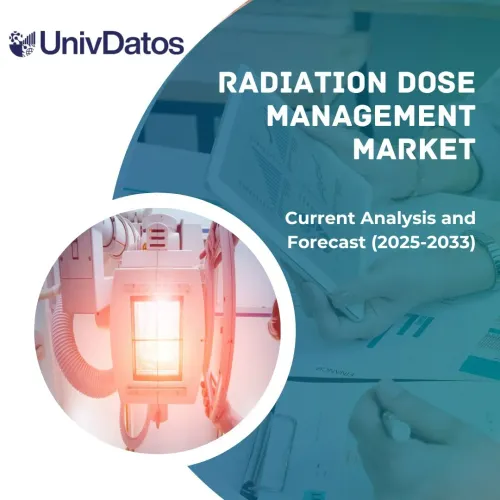- Home
- About Us
- Industry
- Services
- Reading
- Contact Us
Lymphatic Malformations Market: Current Analysis and Forecast (2023-2030)
Emphasis on Application (Diagnosis and Treatment); End User (Hospitals, Clinics, and Others); and Region/Country
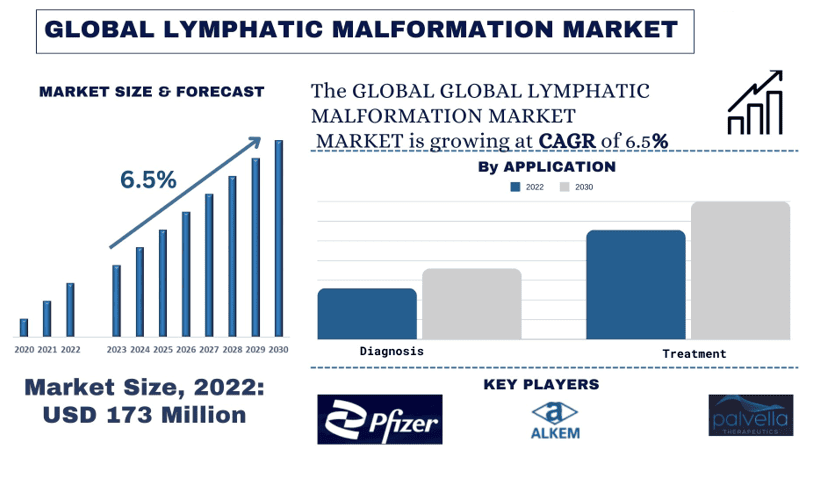
Lymphatic Malformation Market Size and Forecast
The Lymphatic Malformation Market was valued at USD 173.24 Million in 2022 and is expected to grow at a CAGR of 6.54% during the forecast period (2023-2030).
Lymphatic Malformation Market Analysis
Lymphatic Malformations (LMs) are congenital anomalies of the lymphatic system, characterized by abnormal growth and development of lymphatic vessels. These malformations can occur anywhere in the body but are mostly found in the head and neck region, including the face, neck, and oral cavity. Lymphatic malformation mainly gained prominence in the market due to the rising government initiatives for developing treatments for the ailment. For instance, in March 2024, the National Heart, Lung, and Blood Institute helped launch the first National Institutes of Health-National Commission on Lymphatic Diseases to establish a national body to advance lymphatics research. In addition to this, investments in healthcare departments as well as government awareness programs regarding lymphatic malformation have increased significantly in recent years, which are the key factors that are creating opportunities for the market.
Pfizer Inc.; Protara Therapeutics; Zydus Pharmaceuticals, Inc.; Palvella Therapeutics; Avalo Therapeutics, Inc.; Alkem Laboratories Ltd.; GLENMARK PHARMACEUTICALS LTD. are some of the key players in the market. Several M&As along with partnerships have been undertaken by these players to facilitate customers with hi-tech and innovative products/technologies.
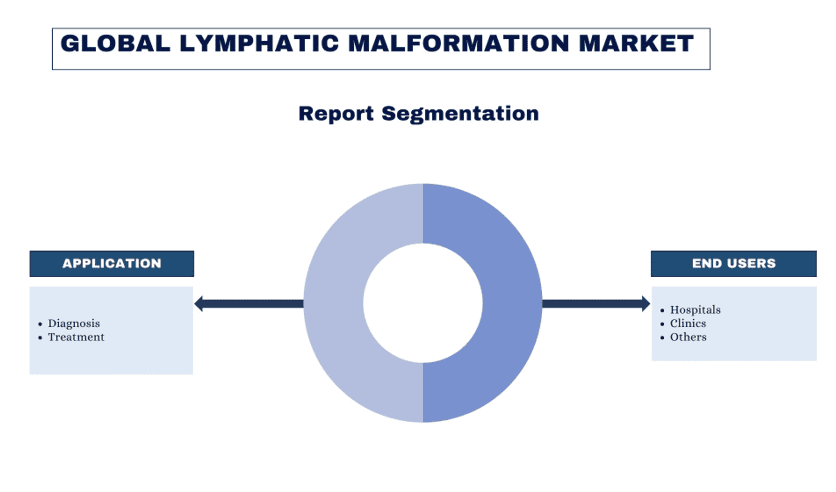
Lymphatic Malformation Market Trends
“Amongst application, treatment category to witness higher CAGR during the forecast period”
Based on the application, the market is bifurcated into diagnosis and treatment. The treatment segment is expected to grow with a high CAGR during the forecast period because of the rising number of clinical trials. For instance, in February 2023, Novartis Pharmaceuticals initiated a study in participants with PIK3CA-mutated lymphatic malformations (LyM) to assess the change in radiological response and symptom severity upon treatment with alpelisib as compared to placebo. Pharmaceutical companies and academic institutions are investing in research and development to develop novel treatment strategies for lymphatic retinopathy. The growth of the treatment segment is driven by technological innovation, increasing disease prevalence, improved access to healthcare services, and a growing emphasis on early intervention and combination therapy approaches. Thus, the treatment segment among applications is expected to witness a higher CAGR during the forecast period.
“Amongst end user, hospitals held a significant share in the market in 2022”
Based on end user, the market is categorized into hospitals, clinics, and others. The hospital segment is dominating the market owing to the rising hospital admissions for lymphatic malformations globally. This is due to higher diagnostic tests of lymphatic malformations in hospitals as most diagnostic equipment is available in hospital settings. Apart from this, the growing number of hospitals is also propelling segmental growth. For instance, according to the American Hospital Association, there were about 6,093 hospitals in the U.S. in October 2022, which comprises community hospitals run by non-profit organizations as well as by state and local governments. Thus, hospitals held a significant share of the lymphatic malformation market in 2022.
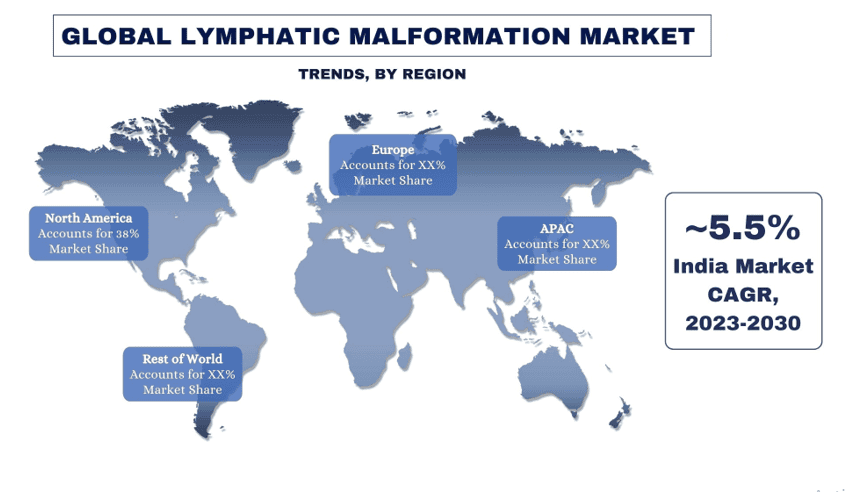
“Amongst regions, APAC is expected to witness a higher CAGR during the forecast period”
APAC is expected to grow with a high CAGR in the global lymphatic malformation market in the forecast period. Several factors such as a surge in the number of clinical trials being performed, enhanced accessibility, and diversified healthcare costs are driving the market’s growth during the forecast period. Further, the increase in incidences of lymphatic malformation is also having a positive impact on the market’s growth. There have been major awareness programs regarding lymphatic malformation and product launches in the region. For instance, in March 2021, Japan-based ARTham Therapeutics received a rare disease drug development grant from the Agency for Medical Research and Development for its ART-001 program for the development of the treatment of slow-flow vascular malformations. Thus, APAC is expected to witness a higher CAGR during the forecast period.
Lymphatic Malformations Market Report Coverage
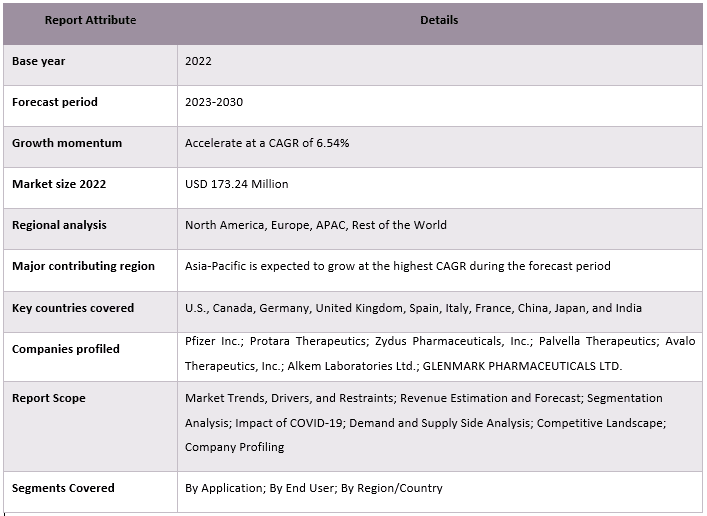
Reasons to buy this report:
- The study includes market sizing and forecasting analysis validated by authenticated key industry experts.
- The report presents a quick review of overall industry performance at one glance.
- The report covers an in-depth analysis of prominent industry peers with a primary focus on key business financials, product portfolio, expansion strategies, and recent developments.
- Detailed examination of drivers, restraints, key trends, and opportunities prevailing in the industry.
- The study comprehensively covers the market across different segments.
- Deep dive regional level analysis of the industry.
Customization Options:
The Global Lymphatic Malformation Market can further be customized as per the requirement or any other market segment. Besides this, UMI understands that you may have your own business needs, hence feel free to connect with us to get a report that completely suits your requirements.
Table of Content
Research Methodology for the Lymphatic Malformation Market Analysis (2023-2030)
Analyzing the historical market, estimating the current market, and forecasting the future market of the global lymphatic malformation market were the three major steps undertaken to create and analyze the adoption of lymphatic malformation in major regions globally. Exhaustive secondary research was conducted to collect the historical market numbers and estimate the current market size. Secondly, to validate these insights, numerous findings and assumptions were considered. Moreover, exhaustive primary interviews were also conducted, with industry experts across the value chain of the global lymphatic malformation market. Post assumption and validation of market numbers through primary interviews, we employed a top-down/bottom-up approach to forecasting the complete market size. Thereafter, market breakdown and data triangulation methods were adopted to estimate and analyze the market size of segments and sub-segments of the industry pertains to. Detailed methodology is explained below:
Analysis of Historical Market Size
Step 1: In-Depth Study of Secondary Sources:
Detail secondary study was conducted to obtain the historical market size of the lymphatic malformation market through company internal sources such as annual reports & financial statements, performance presentations, press releases, etc., and external sources including journals, news & articles, government publications, competitor publications, sector reports, third-party database, and other credible publications.
Step 2: Market Segmentation:
After obtaining the historical market size of the lymphatic malformation market, we conducted a detailed secondary analysis to gather historical market insights and share for different segments & sub-segments for major regions. Major segments are included in the report as application, end user, and regions. Further country-level analyses were conducted to evaluate the overall adoption of testing models in that region.
Step 3: Factor Analysis:
After acquiring the historical market size of different segments and sub-segments, we conducted a detailed factor analysis to estimate the current market size of the lymphatic malformation market. Further, we conducted factor analysis using dependent and independent variables such as application, end user, and regions of lymphatic malformation. A thorough analysis was conducted for demand and supply-side scenarios considering top partnerships, mergers and acquisitions, business expansion, and product launches in the lymphatic malformation market sector across the globe.
Current Market Size Estimate & Forecast
Current Market Sizing: Based on actionable insights from the above 3 steps, we arrived at the current market size, key players in the global lymphatic malformation market, and market shares of the segments. All the required percentage shares split and market breakdowns were determined using the above-mentioned secondary approach and were verified through primary interviews.
Estimation & Forecasting: For market estimation and forecast, weights were assigned to different factors including drivers & trends, restraints, and opportunities available for the stakeholders. After analyzing these factors, relevant forecasting techniques i.e., the top-down/bottom-up approach were applied to arrive at the market forecast for 2030 for different segments and sub-segments across the major markets globally. The research methodology adopted to estimate the market size encompasses:
- The industry’s market size, in terms of revenue (USD) and the adoption rate of the lymphatic malformation market across the major markets domestically
- All percentage shares, splits, and breakdowns of market segments and sub-segments
- Key players in the global lymphatic malformation market in terms of products offered. Also, the growth strategies adopted by these players to compete in the fast-growing market
Market Size and Share Validation
Primary Research: In-depth interviews were conducted with the Key Opinion Leaders (KOLs) including Top Level Executives (CXO/VPs, Sales Head, Marketing Head, Operational Head, Regional Head, Country Head, etc.) across major regions. Primary research findings were then summarized, and statistical analysis was performed to prove the stated hypothesis. Inputs from primary research were consolidated with secondary findings, hence turning information into actionable insights.
Split of Primary Participants in Different Regions
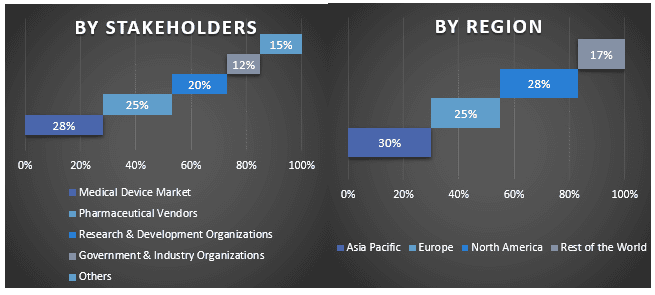
Market Engineering
The data triangulation technique was employed to complete the overall market estimation and to arrive at precise statistical numbers for each segment and sub-segment of the global lymphatic malformation market. Data was split into several segments & sub-segments post studying various parameters and trends in the areas of application, end user, and regions in the global lymphatic malformation market.
The main objective of the Global Proteasome Inhibitor Market Study
The current & future market trends of the global lymphatic malformation market were pinpointed in the study. Investors can gain strategic insights to base their discretion for investments on the qualitative and quantitative analysis performed in the study. Current and future market trends determined the overall attractiveness of the market at a regional level, providing a platform for the industrial participant to exploit the untapped market to benefit from a first-mover advantage. Other quantitative goals of the studies include:
- Analyze the current and forecast market size of the lymphatic malformation market in terms of value (USD). Also, analyze the current and forecast market size of different segments and sub-segments.
- Segments in the study include areas of application, end user, and regions.
- Define and analyze the regulatory framework for the lymphatic malformation industry.
- Analyze the value chain involved with the presence of various intermediaries, along with analyzing customer and competitor behaviors of the industry.
- Analyze the current and forecast market size of the lymphatic malformation market for the major region.
- Major countries of regions studied in the report include Asia Pacific, Europe, North America, and the Rest of the World.
- Company profiles of the lymphatic malformation market and the growth strategies adopted by the market players to sustain in the fast-growing market.
- Deep dive regional level analysis of the industry.
Frequently Asked Questions FAQs
Q1: What is the current market size and growth potential of the lymphatic malformation market?
Q2: What are the driving factors for the growth of the lymphatic malformation market?
Q3: Which segment has the largest share of the lymphatic malformation market by application?
Q4: What are the emerging technologies and trends in the lymphatic malformation market?
Q5: Which region will dominate the lymphatic malformation market?
Q6: Who are the key players operating in the lymphatic malformation market?
Related Reports
Customers who bought this item also bought

